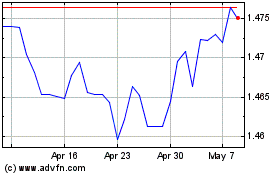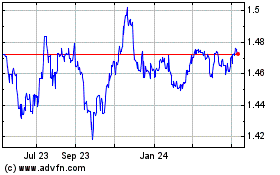Euro Extends Slide After ECB Draghi Reiterates Low Rates
June 14 2018 - 6:12AM
RTTF2
The euro continued to be lower against its key counterparts in
the New York session on Thursday, after the European Central Bank
President Mario Draghi acknowledged that the interest rates are
likely to remain unchanged through summer 2019 amid rising economic
uncertainty.
The Governing Council expect the interest rates to remain
unchanged at least through the summer of 2019 and in any case for
as long as necessary to ensure that the evolution of inflation
remains aligned with the expectations of a sustained adjustment
path, Draghi said at press conference.
Although the risks related to the euro area growth outlook
remain broadly balanced, uncertainties related to global factors,
including the threat of increased protectionism, have become more
prominent, he cautioned.
"Moreover, the risk of persistent heightened financial market
volatility warrants monitoring."
The euro area growth for 2018 has been downgraded to 2.1 percent
from 2.4 percent. The GDP outlook for 2019 and 2010 were kept
unchanged at 1.9 percent and 1.7 percent.
Earlier on Thursday, the bank announced that it hopes to halve
its monthly bond purchases to EUR 15 billion after September and to
end them in December.
The Governing Council, which held the latest policy session the
Latvian capital Riga, left the key interest rates unchanged. The
bank said interest rates will remain at their present level at
least through the summer of 2019 and beyond, if necessary.
The euro depreciated to a 9-day low of 0.8732 against the pound,
following an advance to 0.8821 at 7:45 pm ET. The next likely
support for the euro is seen around the 0.86 level.
Figures from the Office for National Statistics showed that UK
retail sales growth accelerated more than expected in May.
Retail sales volume including auto fuel, grew 1.3 percent
month-on-month, following April's 1.8 percent increase. This was
the second consecutive rise in sales and much bigger than the
expected 0.5 percent.
The 19-nation currency fell to near a 2-week low of 1.1619
against the greenback, reversing from an early new 4-week peak of
1.1852. The euro is seen finding support around the 1.15
region.
The single currency slipped to a 6-day low of 128.32 against the
yen, pulling away from an early new 3-week high of 130.36. On the
downside, 127.00 is possibly seen as the next support level for the
euro.
Final data from the Ministry of Economy, Trade and Industry
showed that Japan's industrial production increased more than
initially estimated in April.
Industrial production climbed 0.5 percent month-over-month in
April, faster than the 0.3 percent estimated earlier. It was the
third successive monthly rise.
The euro weakened to a 6-day low of 1.1558 against the franc,
after rising to a 3-day high of 1.1648 at 7:45 am ET. If the euro
falls further, 1.13 is likely seen as its next support level.
The euro reversed from its recent weekly high of 1.5358 against
the loonie, falling to a 9-day low of 1.5119. The euro is poised to
challenge support around the 1.50 level.
Following more than a 2-week high of 1.6841 hit at 7:45 am ET,
the euro fell to more than a 5-month low of 1.6570 against the
kiwi. Continuation of the euro's downtrend may see it challenging
support around the 1.64 level.
The euro fell to a weekly low of 1.5427 against the aussie, down
from near a 4-week high of 1.5693 seen at 7:45 am ET. Next key
support for the euro is likely seen around the 1.53 level.
Euro vs CAD (FX:EURCAD)
Forex Chart
From Mar 2024 to Apr 2024

Euro vs CAD (FX:EURCAD)
Forex Chart
From Apr 2023 to Apr 2024
